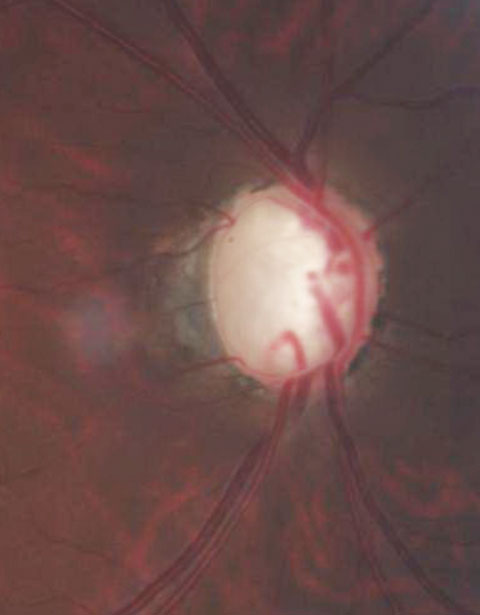 |
A 48-year-old man was referred to our office for urgent glaucoma management. He reported that his sight had been getting worse “over some time” and knew that he had poor vision in his right eye. Indeed, his corrected visual acuity was hand motion in the right eye and 20/30 OS.
He reported no systemic health issues, but said he “didn’t really go to the doctor much.” He had no biomicroscopic abnormalities, and his intraocular pressures (IOP) were 46mm Hg OD and 38mm Hg OS. He had advanced glaucomatous damage to both optic discs.
After a discussion of the diagnosis and treatment options (he adamantly refused surgery), he was prescribed latanoprost in each eye and scheduled for a follow-up; however, it took several months of no-shows before he returned. He reported that he used the medication “a bit,” but didn’t really feel a difference, never refilled the prescription and discontinued after a month. His IOP hadn’t changed. He again refused surgery, was again educated about his prognosis and re-prescribed latanoprost. He has since been lost to follow up.
The Compliance Challenge
The greatest challenge in managing glaucoma has got to be medication adherence. Great IOP lowering medications don’t work if patients don’t use them. Sustained-release medications haven’t been used with any great effect since the 1970s when Ocusert wafers were used to deliver pilocarpine in a more-or-less continuous fashion. It was not readily adapted due to discomfort and the overall poor tolerability of pilocarpine.
Today, many innovators are reviving sustained-release options in an attempt to solve the compliance issue. For instance, bimatoprost SR (Allergan), is an intracameral depot implant placed in the anterior chamber. Bimatoprost SR is a biodegradable polymer matrix that releases a steady amount of bimatoprost 0.03%.1 One study shows the overall mean IOP reduction from baseline through week 16 using bimatoprost SR was 7.2mm Hg, 7.4mm Hg, 8.1mm Hg and 9.5mm Hg with the 6-µg, 10-µg, 15-µg, and 20-µg dose strengths of implant, respectively, vs. 8.4mm Hg in topical bimatoprost-treated fellow eyes.1 The implant lowered IOP in 92% of patients at four months and 71% at six months.1 No serious adverse ocular events were noted, and the most common adverse events were related to the injection procedure.1
Similarly used as an intracameral implant is ENV515 (Envisia), an extended release form of travoprost. A Phase 2a open-label, 28-day dose-ranging study of 21 patients yielded 28% IOP lowering at day 25 in one group, which was comparable with once-daily Travatan Z (travoprost, Alcon).2 Interim Phase 2 results showed a favorable safety profile and sustained IOP reduction up to three months.2 Envisia is planning to advance to a 12-month study to evaluate the long-term IOP lowering of ENV515.2
 |
| Researchers are investigating whether glaucoma patients, such as the one shown in this photo, may be better treated using sustained-release medications. |
Sustained-release Devices
Additionally, researchers have considerable work to do on sustained-release platforms delivered externally. One such device is a bimatoprost-laden ring being developed by Allergan. This thin silicone ring suffused with bimatoprost that slowly releases medication over time is fit under the upper and lower eyelids by a doctor, so that it rests in the conjunctival sulcus. It is designed to be replaced every six months. In a Phase 2 randomized, double-masked controlled study, the bimatoprost-delivery device was compared with timolol 0.5% BID. The bimatoprost ring lowered IOP, but less than did topical timolol 0.5% dosed twice daily. Retention was 90% at six months and was generally well tolerated by the study patients.3 There exists a possibility to develop the device to contain a fixed combination of bimatoprost and timolol.
Beyond an externally applied medication-eluting conjunctival ring, punctal plugs may serve as a promising method of delivering sustained-release medications via punctual plugs.4 Ocular Therapeutix is developing the OTX-TP, a travoprost-eluting intracanalicular punctal plug designed to slowly deliver the medication. It can be placed in either the superior or inferior canaliculus. Because it is intracanalicular, it can only be visualized in place by a fluorescent light, thus retention cannot be determined by the patient. In clinical trials, retention of the OTX-TP device was 91% at 60 days but only 48% at 90 days.5 One study noted that IOP with OTX-TP was reduced 23% to 28% at day 10.3 However, at 30 days, plug retention had declined to 42%, and the overall IOP reduction had decreased to 16%.5
Mati Therapeutics is working on its own drug-eluting punctal plug, the latanoprost-punctal plug delivery system, which releases latanoprost and is grossly visible. As a superficial punctal plug, it can be verified present and pulled out relatively easily.6
Pitfalls
The concept of sustained-release devices for glaucoma medications is exciting and promises to reduce adherence and persistence issues. However, they carry potential drawbacks.
In regards to injectable implants, a medication cannot be easily discontinued if there is an adverse reaction, whereas a patient can simply stop using a topical drop. Anterior chamber implants can, theoretically, block parts of the angle or even a trabeculectomy site. Invasive options carry the risk of infection and even endophthalmitis. Also, a great many patients are cared for by optometrists. Should the direction of glaucoma care shift towards invasive options, access to care will decrease as these options may be beyond the scope of optometric licensure. Also, it is not clear if insurance will pay for these medications and procedures simply to increase adherence. Further, glaucoma patients who perceive no vision loss may not be as accepting of an injection into the eye as those, say, with severely deteriorating vision from macular degeneration. Intravitreal therapy for macular degeneration has shown great advances in vision recovery and preservation, but those patients who have dropped out of regimented therapy are mostly doing poorly.
Still a Ways Away
As for externally delivered sustained-release options, patients will have to verify if a punctal plug or ring is still in place. Retention of external devices may pose a problem for patients who are scheduled for replacement at three- or six-month intervals. It may be that patients are not receiving therapy for a significant period of time between visits. There will be limitations on the number of drugs that can be placed within the anterior chamber or into a medication-eluting ring. Patients also, obviously, have a limited number of puncta, and additional topical therapy may still be needed.
Some drugs may work better in pulsatile form and not so well in constant delivery systems. We know that prostaglandin analogs are less effective at BID dosing, likely due to receptor supersaturation and desensitization.7 Likely, the once-a-day dosing of these medications provides needed downtime between drops to prevent receptor desensitization. In clinical trials, it appears that these sustained-release prostaglandins are not as effective at lowering IOP as they are in topical form.3
Sustained delivery of glaucoma therapy is still several years away. Some options will be invasive, which may limit access to care. Many options will be noninvasive. All offer some benefits combined with limitations. We anxiously await the results from clinical trials and the introduction of these devices to the ophthalmic marketplace. However, we believe that drops, laser and surgery will not become obsolete any time soon.
| 1. Lewis RA, Christie WC, Day DG, et al. Bimatroprost SR Study Group. Bimatoprost sustained-release implants for glaucoma therapy: 6-month results from a Phase I/II clinical trial. Am J Ophthalmol. 2016 March;175:137-47. 2. Navratil T, Garcia A, Tully J, et al. Preclinical evaluation of ENV515 (travoprost) intracemeral implant-clinical candidate for treatment of glaucoma targeting six-month duration of action. Paper presented at ARVO; May 6, 2014; Orlando, FL. 3. Brandt JD, Sall K, DuBiner HB, et al. 6-month IOP-reduction with a single dose of a novel topical bimatroprost ocular insert: a phase 2 randomized, double-masked, controlled study. Paper presented at the AAO Annual Meeting; November 17, 2015; Las Vegas. 4. Aref AA. Sustained drug delivery for glaucoma: current data and future trends. Curr Opin Ophthalmol. 2017;28(2):169-174. 5. Perera SA, Ting DS, Nongpiur ME, et al. Feasibility study of sustained-release travoprost punctum plug for intraocular pressure reduction in an Asian population. Clin Ophthalmol. 2016;10(4):757-64. 6. Mati Therapeutics. Mati Therapeutics Inc announces initiation of phase II study to compare latanoprost punctal plug delivery system (L-PPDS) to timolol eye drops. bit.ly/1Mdcvwo. October 28, 2013. Accessed March 9, 2017. 7. Brandt JD, VanDenburgh AM, Chen K, et al. Comparison of once- or twice-daily bimatoprost with twice-daily timolol in patients with elevated IOP : a 3-month clinical trial. Ophthalmology. 2001 Jun;108(6):1023-31. |

